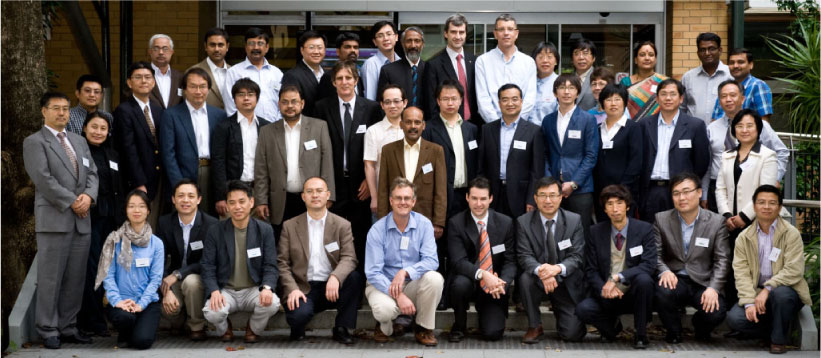2nd International Collaborative and Cooperative Chemistry Symposium
Craig M. WilliamsSchool of Chemistry and Molecular Biosciences, University of Queensland, Brisbane, Qld 4072, Australia. Email: c.williams3@uq.edu.au

Craig M. Williams received his B.Sc. (Hons) degree in chemistry in 1994, and in 1997 he was awarded his Ph.D. in organic chemistry from Flinders University under the supervision of Professor Rolf H. Prager. He worked as an Alexander von Humboldt Postdoctoral Fellow with Professor Armin de Meijere at the Georg-August-Universität, Göttingen, Germany, until 1999 and then took up a postdoctoral fellowship at the Australian National University with Professor Lewis N. Mander. He has held an academic position – currently Associate Professor – at the University of Queensland since 2000 and during this time he has won a number of awards, including a Thieme Chemistry Journals Award in 2007. The primary research focus of the Williams group is the construction of biologically active complex natural products and designing methodology to assist in this endeavour. |
Australian Journal of Chemistry 65(9) 1260-1261 https://doi.org/10.1071/CH12231
Published: 26 September 2012
The last time I wrote a foreword was on the occasion of the University of Queensland (UQ)–National University of Singapore (NUS) joint symposium (SAuCCCS-2) held at UQ in December 2008.[1]
It is with immense pleasure, through this month’s special issue of the Australian Journal of Chemistry, that I herein provide an update on the evolution that this event has undergone in the last four years and thank Professor Curt Wentrup for the enjoyable task of broadcasting this resulting research front.
The historical beginnings of the UQ Chemistry relationship with our Asian partners formed over five years ago through a wonderful leadership initiative taken by NUS to strengthen regional cooperation in the discipline of chemistry. This initiative, driven under the guidance of Professor Andy Hor, was commemorated with the Singapore-Australia Chemistry Symposium held at NUS in 2006, which was followed in 2008 by a UQ-NUS Chemistry meeting (SAuCCCS-2),[1] held on the St Lucia campus. In November 2010, UQ Chemistry was invited to participate in the two-day inaugural International Collaborative and Cooperative Chemistry Symposium (ICCCS), led by Professor Guo Qin Xu and Professor Hian Kee Lee, which brought together leading universities from the Asia-Oceania region: NUS; University of Hyderabad; Seoul National University; Zhejiang University; Kyoto University; Indian Institute of Technology-Kanpur; and Peking University. This resulted in a research front in the May 2011 issue of the Australian Journal of Chemistry, with Professor James De Voss as guest editor.
It was agreed that the ICCCS symposium would be held annually, and the University of Queensland was chosen to host the 2nd International Collaborative and Cooperative Chemistry Symposium (2nd ICCCS) from 30 October to 2 November in 2011.
As 2011 was the International Year of Chemistry, this was excellent timing for UQ, and the themed event titled ‘Chemistry for the Future’ was therefore very fitting. Invited UQ speakers from the School of Chemistry and Molecular Biosciences, the Institute of Molecular Biosciences and the Australian Institute for Nanotechnology and Biotechnology joined speakers from the visiting institutions (totalling 40 presentations) in covering exciting chemical innovations underpinning approaches to solving modern societal issues in fields such as medicine and energy (Fig. 1).
Representing the meeting’s scientific diversity in this research front are elegant contributions to the areas of synthetic organic methodology (Shimizu et al.[2]; Ghorai et al.[3]); green chemistry (Khara and Samanta[4]); medicinal and biological chemistry (Nakka and Guruprasad[5]; Astarina et al.[6]; Yadav et al.[7]); polymer and materials chemistry (Ahmad et al.[8]) and in-depth spectroscopy using magnetic circular dichroism (Riley et al.[9]).
Finally, I would like to sincerely thank the Department of Chemistry at NUS for taking the courage to establish this very important international ‘chemical’ relationship, which has born new friendships, exchanges and collaborations, and not to forget wonderful issues of the Australian Journal of Chemistry.
References
[1] C. Williams, Aust. J. Chem. 2009, 62, 949.| Crossref | GoogleScholarGoogle Scholar | 1:CAS:528:DC%2BD1MXhtFensLbF&md5=f4fa4543ed5b141f5b92250eb1c5aa5bCAS |
[2] M. Shimizu, I. Nagao, S.-i. Kiyomoto, T. Hiyama, Aust. J. Chem. 2012, 65, 1277.
| Crossref | GoogleScholarGoogle Scholar |
[3] M. K. Ghorai, S. Halder, S. Samanta, Aust. J. Chem. 2012, 65, 1262.
| Crossref | GoogleScholarGoogle Scholar |
[4] D. C. Khara, A. Samanta, Aust. J. Chem. 2012, 65, 1291.
| Crossref | GoogleScholarGoogle Scholar |
[5] S. Nakka, L. Guruprasad, Aust. J. Chem. 2012, 65, 1314.
| Crossref | GoogleScholarGoogle Scholar |
[6] A. Astarina, M. J. Chow, W. H. Ang, Aust. J. Chem. 2012, 65, 1271.
| Crossref | GoogleScholarGoogle Scholar |
[7] R. Yadav, S. Das, P. Sen, Aust. J. Chem. 2012, 65, 1305.
| Crossref | GoogleScholarGoogle Scholar |
[8] M. Ahmad, M. K. Sharma, R. Singh, J. Mrozinski, P. K. Bharadwaj, Aust. J. Chem. 2012, 65, 1285.
| Crossref | GoogleScholarGoogle Scholar |
[9] M. J. Riley, J. Hall, E. R. Krausz, Aust. J. Chem. 2012, 65, 1298.
| Crossref | GoogleScholarGoogle Scholar |



